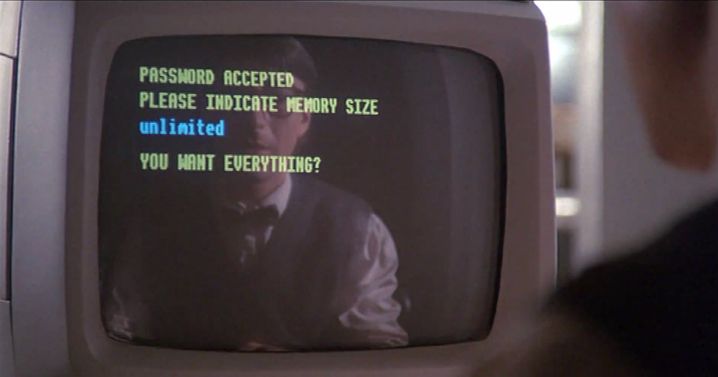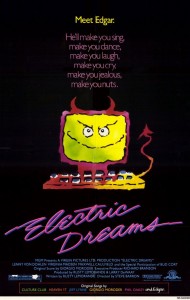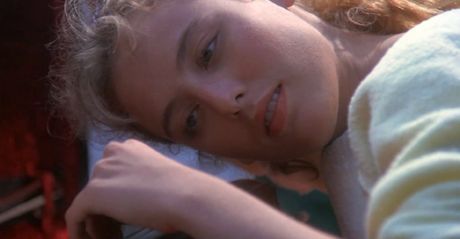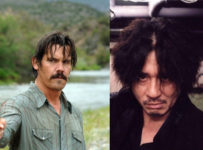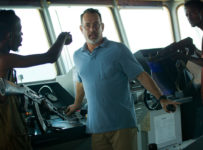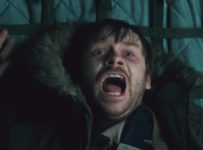Welcome back to 80s Bits, the weekly column in which we explore the best and worst of the Decade of Shame. With guest writers, hidden gems and more, it’s truly, truly, truly outrageous.
[stextbox id=”grey” caption=”Electric Dreams (1984)” float=”true” align=”right” width=”220″]
Director: Steve Barron
Runtime: 96 minutes
Starring: Lenny von Dohlen, Virginia Madsen, Bud Cort
Studio: MGM
Country: US
Rating: Rental for Sure (?)
More 80s Bits [/stextbox]
It may be hard to believe as you sit down to read this on your PC, laptop, tablet or mobile device, but there was a time when personal computers were a bit of a novelty. Prior to the 1980s, computers in films were seen as monolithic entities that either had the power to control everything or were a bit of a joke. Indeed, prior to the 1980s, this was true of a vast number of computers, and films such as Disney’s The Computer Wore Tennis Shoes reflected this humourous take.
As with all new technologies, the increased miniaturisation of computers and their entry into the home brought with it a corresponding fear of the unknown and their potential to take over our lives. 1982’s Tron took us inside the computer to a digital world with entities who wanted to take over our reality, while 1983’s War Games aimed to show how easy it was for a single young hacker to inadvertently initiate nuclear annihilation.
In Electric Dreams, Miles Harding (Lenny von Dohlen) is an architect attempting to design a jigsaw-shaped piece to enable buildings to withstand earthquakes. After buying a computer to help him get organised, he begins to add gadgets to it, slowly allowing the computer control over various aspects of his household life. When Miles attempts to access the mainframe at work, the computer begins to overheat, and the not-too-bright Miles tries to cool the machine down with champagne. Somehow this causes the computer to become sentient, and it begins to learn from Miles. Meanwhile, when attractive musician Madeline (Virginia Madsen) moves in next door, the computer forms a fascination with her and begins to compose music based on what he hears drifting through the air vents. So begins a bizarre love triangle with Miles, Madeline and a computer.
This typically chaotic concept could only come from the 1980s, and the mind of writer Rusty Lemorande, who is perhaps best known outside film circles for penning the story to the Disneyland Michael Jackson attraction Captain EO. Yet it is the aesthetic of director Steve Barron that is strongest here, drawing heavily from his music video background that arguably defined the decade. Along with his contemporaries Russell Mulcahy and Julien Temple, Barron made the transition to the big screen before and after shooting videos for Adam Ant (“Antmusic”), Culture Club (“Karma Chameleon”), Madonna (“Burning Up”), Toto (“Africa”) and the seminal and groundbreaking clips for Michael Jackson (“Billie Jean”) and A-Ha (“Take On Me”). Barron brings this look, and much of the fractured narrative of the 1980s music video, to the film. Witness the way the ‘champagne scene’ plays out, interplaying rapid-fire close-ups with slow-motion waves of bubbly across the circuit boards.
Music plays a huge part in many of the films we discuss in 80s Bits, and in Electric Dreams it is part of the plot. Composer Gorigio Moroder had won the Academy Award the previous year for the title song to Flashdance, and his digitally synth-inspired track that weaves in classical elements is clearly aiming to replicate this success. Of course, the most memorable song in the film is “Together In Electric Dreams”, created by Moroder and Phil Oakley of The Human League, for whom Barron had directed the debut music video (“Don’t You Want Me”) for. The song was a massive hit, and it is perhaps incredible telling that it continues to be far more recognisable than the film from which it came.
[stextbox id=”custom” caption=”The Reel Bits”]While Electric Dreams may be more memorable for the music at its core, along with launching the career of future Oscar-nominee Virginia Madsen (Sideways), it remains a time capsule of a society that was on the verge of a technological revolution, but not entirely sure what that would mean yet.[/stextbox]

